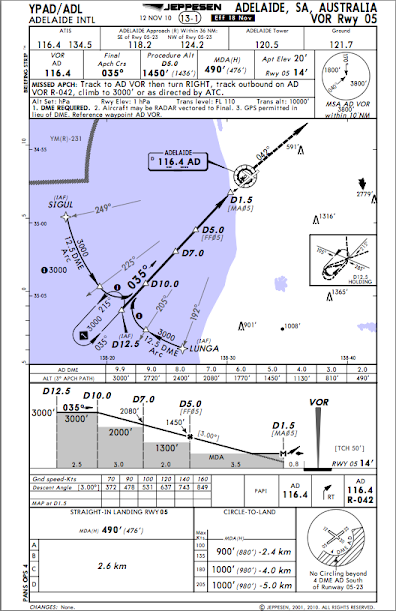Originally Posted by roulishollandais
How are you descending CDA when you reach altitude of a fix or MDA without stopping stabilized approach with GO A ROUND or level the flight until the next fix distance at that height?? ? So you cannot claim to only use that method without using Dive&drive technic, and not training Dive&drive NPA getting out of practice of Dive&Drive??? . Stabilizing the approach in short final is fine on airliners but the intermediate and final approach must manage TRANSIENT regimes.
No, it doesn't have to.
Look, here is how I fly an NPA. This is in a very steam driven four engined jet with no VNAV and no vertical guidance from the FMC, I can't even select a specific VS, it is easiest to hand-fly NPAs in this machine for that reason. I'll use the Adelaide VOR approach to RW05 as an example.
Note how the approach chart has a handy altitude/DME distance scale between the plan view and profile view? It effectively starts at 10nm and gives you an altitude every mile that puts you on a 3º slope to the touchdown zone and stays above all of the steps. This is the meat of this CDA approach, stay on that profile and you will have 2reds/2whites on the PAPI at the minima (or close enough to make it work from there.)
You could work out your own profile if the chart didn't provide it or you wanted easier numbers to work with.

Now, I look at that profile and I say, for a gross error check, that after leaving 3000 feet at 10 DME and noting the limiting step at 7 DME, if I am about 3 x DME - 100 feet I am close enough to the profile. If I can I will follow the profile as written with support from the PNF but if we can't check it exactly at some point I know that 3 x DME - 100 is safe and will leave me in a good position at the MDA.
So the maths from 3000'/10 DME is already done for me. Now I have to work out how to get to 3000'/10 DME. Assuming tracking via LUNGA, I can see it is about 5 NM of arc and another 2.5 NM to the 3000/10 point. You lose a mile or two cutting the corner in the turn so I'll call it 6 track miles between LUNGA and 3000/10, at a TAS of 180 knots that will take 2 minutes. If I use a comfortable 700 fpm descent between LUNGA and 3000/10 I can see that I need to hit LUNGA at 4400 feet. I then work back from 4400'/LUNGA to find a top of descent point and make an allowance for slowing down. Note that I haven't worked out a profile for every mile around the arc or anything, that part isn't critical. It doesn't matter if I'm a little high or low at LUNGA and it doesn't matter if I'm not at exactly 3700' commencing the turn to final, what matters is that I hit the 3000'/10 point accurately and that I cross LUNGA at an altitude that allows me to hit that 3000'/10 point accurately. Something between 4000 and 5000 at LUNGA will work fine.
Now all I have to do is fly the aeroplane to hit the numbers on the approach.
I commence descent at the appropriate time and monitor the enroute descent, adjusting as necessary to hit LUNGA at about 4500 feet / 180 knots / flap 18. Descend on the arc at 700 fpm and continue slowing to 160 knots turning final. Adjusting the descent rate as required so I hit 10 DME at 3000', I continue configuring the aircraft and flying the profile aiming to be stable by 1000' at the latest.
Throughout the final approach the PNF will, workload permitting, monitor the profile and call any deviations, they will also provide the next target. E.g., "9 miles 100 high, 8 miles 2400." I will also be monitoring the profile and adjusting the vertical speed to be as close to the alt/dist profile as I can be. If I can't read the profile for some reason then I will use the 3 x DME - 100 approximate profile that I'd worked out earlier.
As a target vertical speed for the final approach I'll just use ground speed * 5 + 50. At 140 knots that gives me a VS of 750 fpm which is very close to what the chart says on the lower left.
This is the way I've flown NPAs in piston engined twins, turbo-props, and jets. It works in any aeroplane whether it has VNAV or not and doesn't involve destabilising the approach at every limiting step!
Now there are lots of ways to skin a cat, and that is only one way. I'm pretty sure Capt Bloggs would have some different ideas. For one I suspect he works for a company that likes you to work out and write down your own profile. I don't see the point and would rather use the profile on the chart. If my eyes get too old to read it, I'll re write the same profile in nice big letters. But overall, the intent is the same, fly a constant angle descent throughout the approach that keeps you above all altitude restrictions and spits you out the bottom on profile.